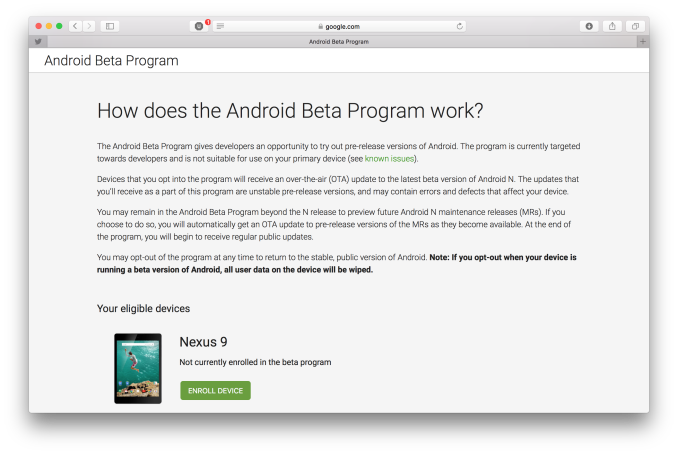Hands-On With the Android N Developer Beta: Multi-Window & More
by Brandon Chester on March 10, 2016 8:00 AM EST- Posted in
- Smartphones
- Android
- Mobile
- Tablets

Yesterday Google surprised a number of people by launching the developer beta of the next release of Android, which is codenamed Android N. Normally the beta version of Android comes to developers during Google I/O in May, but in a way it makes sense for Google to release it to developers a few months earlier so they can receive feedback and discuss common questions and concerns during the event.
The early release isn't the only change with this new beta version of Android. In the past I've often complained about Google's poor handling of developer betas. They've always been too monolithic for my liking, with only two or three betas being released to developers before the final version. There was also the problem with installation. While I am not averse to using the Unix shell, there is no reason that a developer should have to use adb via the command line to install a developer beta of Android. It should be done via an update directly from the device, or by some software tool with a proper graphical interface that can be run on your computer. It didn't help that the update packages often failed to work which required you to decompress it and flash each file one by one.
With Android N, Google has recognized and resolved these problems by providing a simple way for developers to opt in to the program via a web interface. Once you opt in, your device almost instantly receives a notification prompting you to install an over the air (OTA) update which will install the Android N beta. This is much more user friendly, and it has the added bonus of making it easier for users to opt in which gives Google more usage and diagnostic data to work with. Because the OTA isn't just making changes to the existing OS it is quite large, with it being just under 1GB on the Pixel C and Nexus 6, and 1.1GB on the Nexus 5X.
In this article I'll just be taking a look at some of the most notable features of Android N, including Multi-Window mode, changes to notifications, and improvements to energy and memory optimizations.











124 Comments
View All Comments
UtilityMax - Saturday, March 12, 2016 - link
I haven't seen an Android ROM, including among generic AOSP-based ones, that did not have an option to turn the battery percentage on.zeeBomb - Thursday, March 10, 2016 - link
Very niceOmega215D - Thursday, March 10, 2016 - link
Hell, I think Google should address why their crap services keep causong wakelocks. A lot of it is the damn thing phoning home for bullcrap reasons and turning it off breaks a lot of Google apps and phone functionality. Android is becoming worse with each iteration.tuxRoller - Saturday, March 12, 2016 - link
Phoning home?Do you have a source for this claim which proves that "a lot" of the wakelocks address caused by "phoning home" (and, specifically, dealing with Google services without receiving any benefits like informing you of events/places nearby, weather updates, etc).
darkich - Thursday, March 10, 2016 - link
.. and just like that, Android becomes the most promising OS for tabletsmichael2k - Thursday, March 10, 2016 - link
Haha! You mean two years from now, when Android N hits 35% market penetration? Lollipop, in March, just finally beat KitKat (so a 2014 release has higher market share than a 2013 release) in 2016. While iOS 11 (with three years of multitasking and other enhancements) will hit 80% as well has having had multiple developers releasing multiple updates to support all those enhancements? I agree Android is promising, but they have to contend with two dominant powerhouses, Apple and Microsoft, in the tablet space. Apple gets to ride on iPhone sales and Microsoft gets a ride on PC sales.haukionkannel - Thursday, March 10, 2016 - link
Yep, that is still the problem... The os upgrades to Android devices are scarce and come late.Not Googles fault, but the problem is also guite severe to them. The apps are made for those very old versions of os, because most Android devices use those versions, so Android apps will be behind iOs and Windows apps in that aspect.
raptormissle - Thursday, March 10, 2016 - link
You clearly do not understand how Android apps are developed. To imply that Android apps are made for "those very old versions of os" was a very silly comment. Most features in the new SDK are backported to previous versions via the app compatibility libraries. Do some research next time.As for windows apps...well that is so hilarious I'm not even going to go there.
raptormissle - Thursday, March 10, 2016 - link
>but they have to contend with two dominant powerhouses, Apple and Microsoft, in the tablet space.LOL, did you just say Windows was a dominant powerhouse in the tablet space? LOL You were joking right? Windows tablets are right down there with windows phones.
michael2k - Thursday, March 10, 2016 - link
You're ignoring PCs, which currently still dwarf tablets about 5:1 (45m to 246m in 2015). Gartner also lists Microsoft in the top 5, behind Samsung, Apple, Lenovo, and Huawei (in that order) in the tablet space. So, no, actually, not a joke. Microsoft is always free to screw up, though.